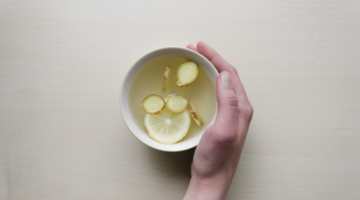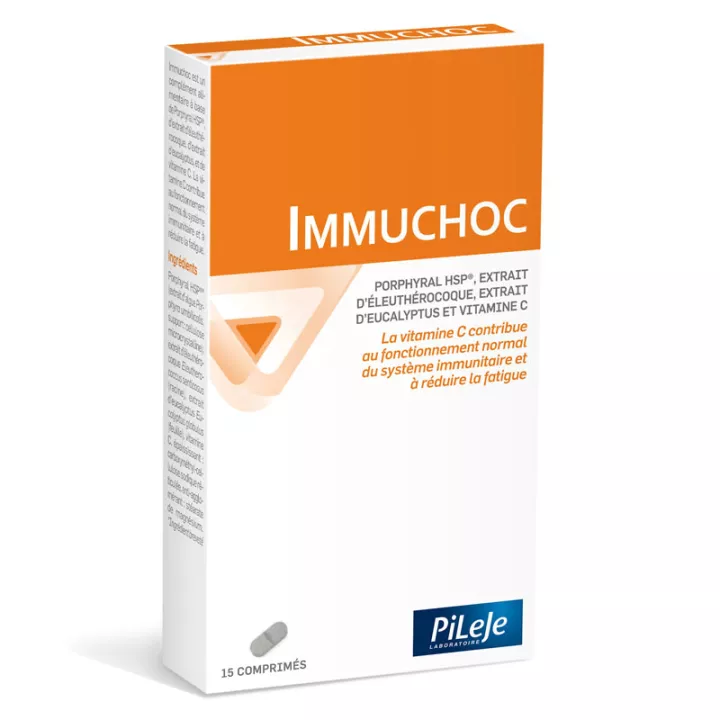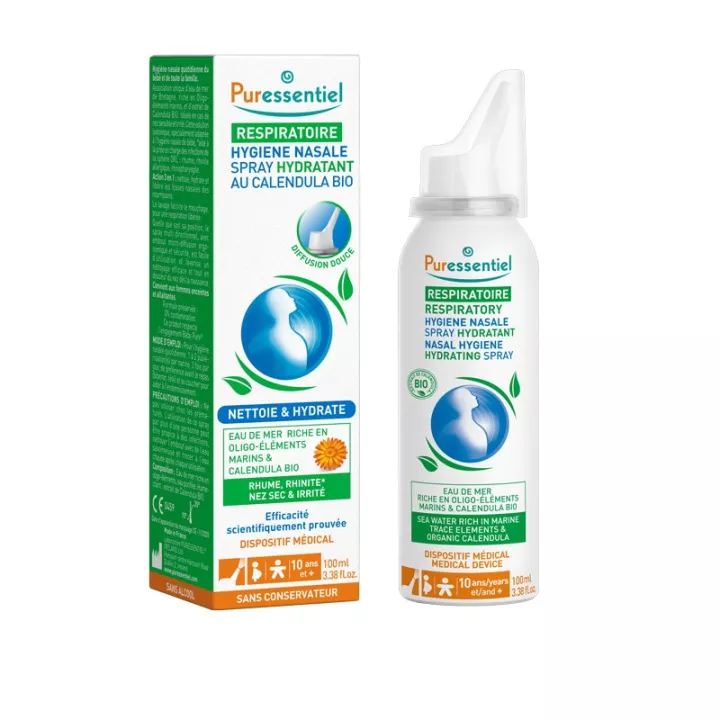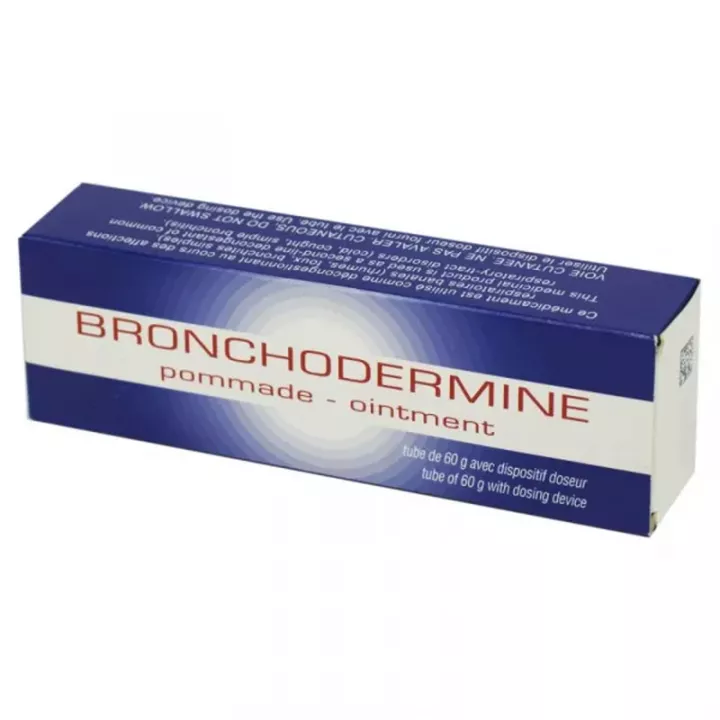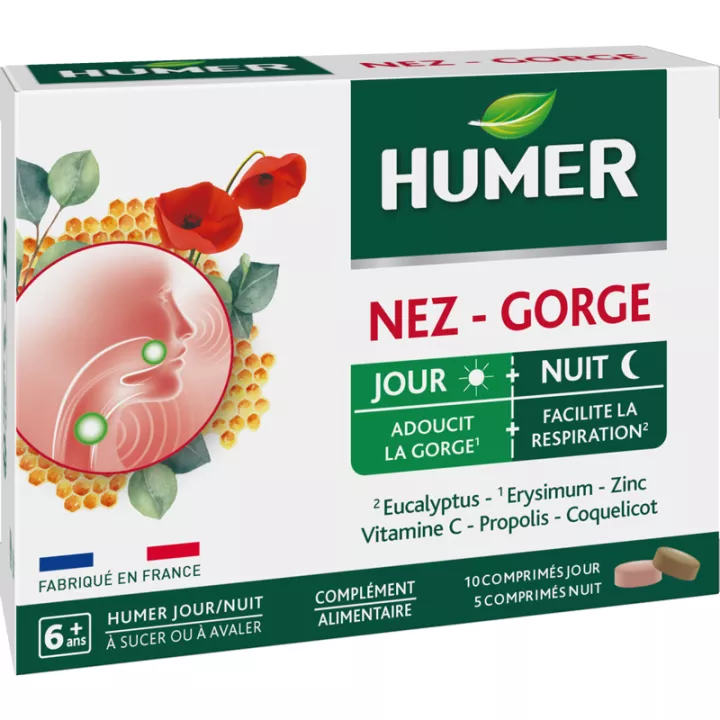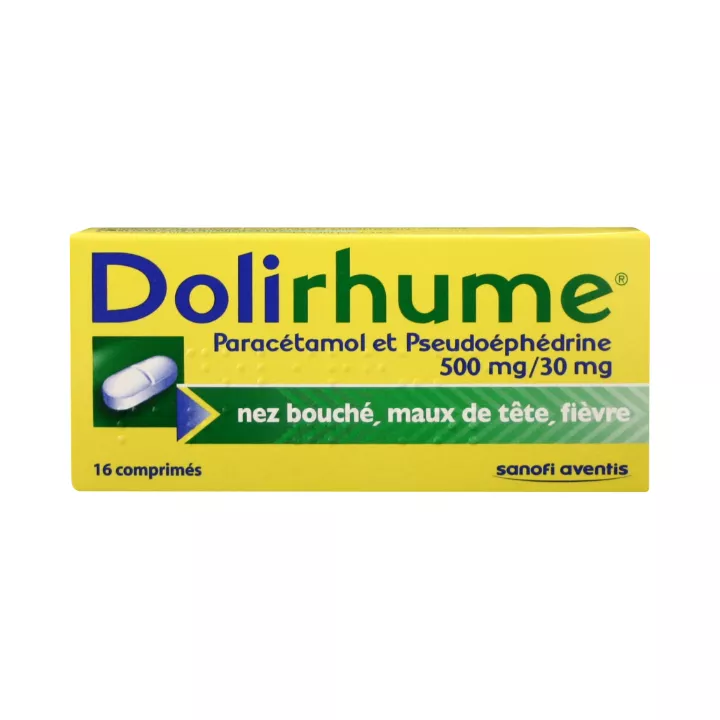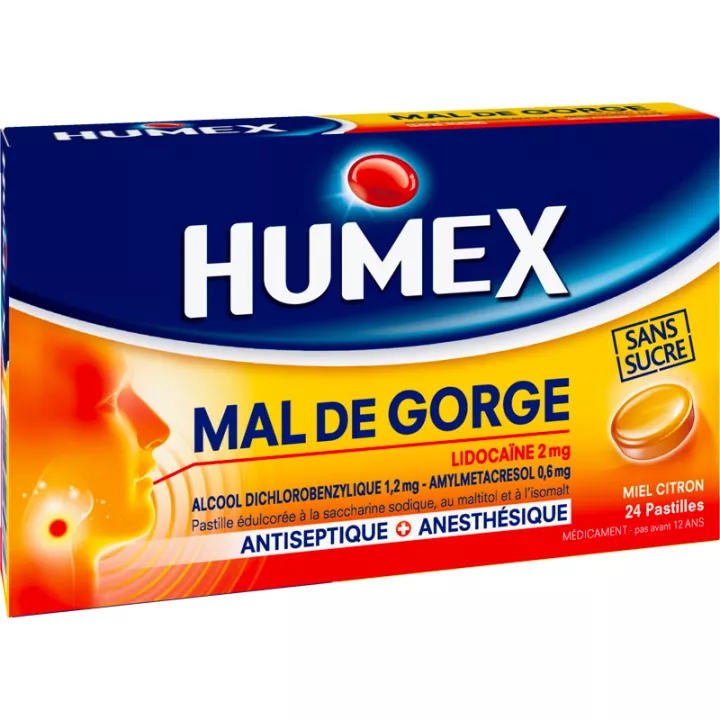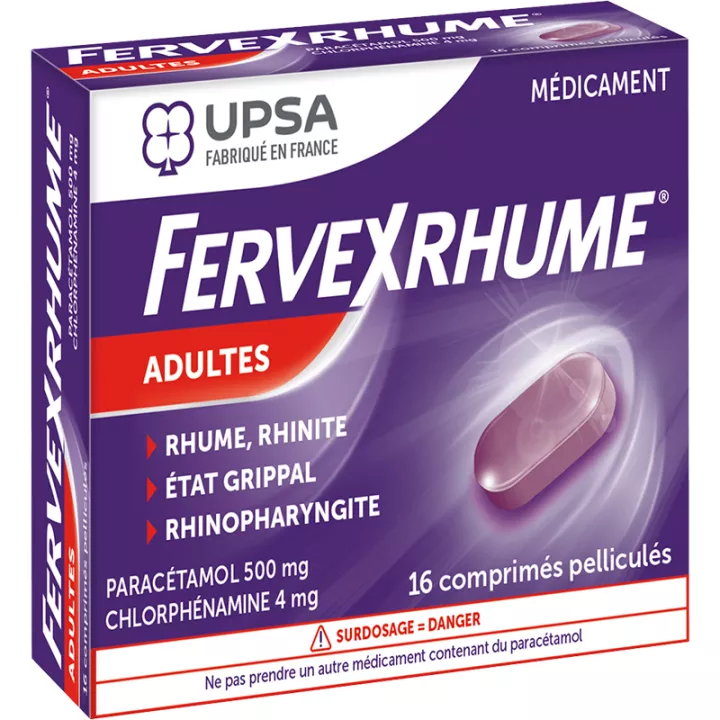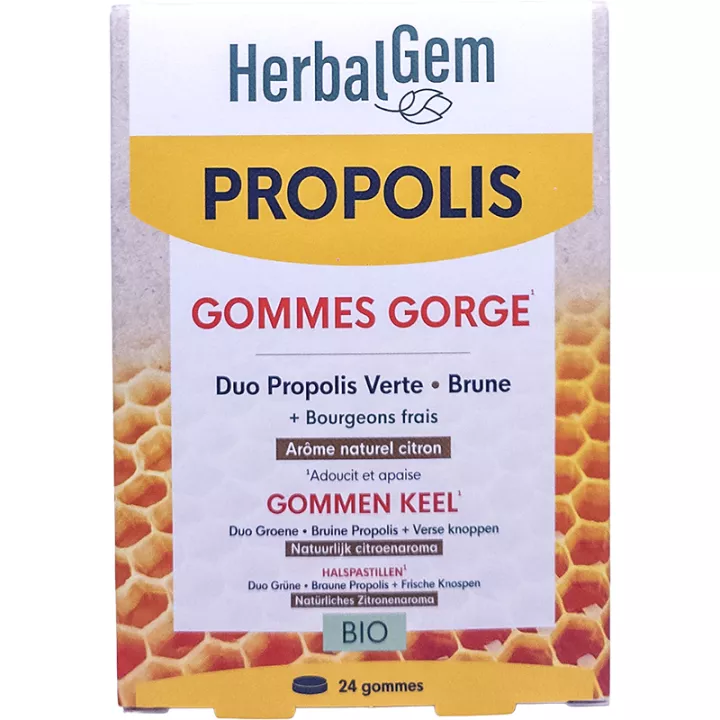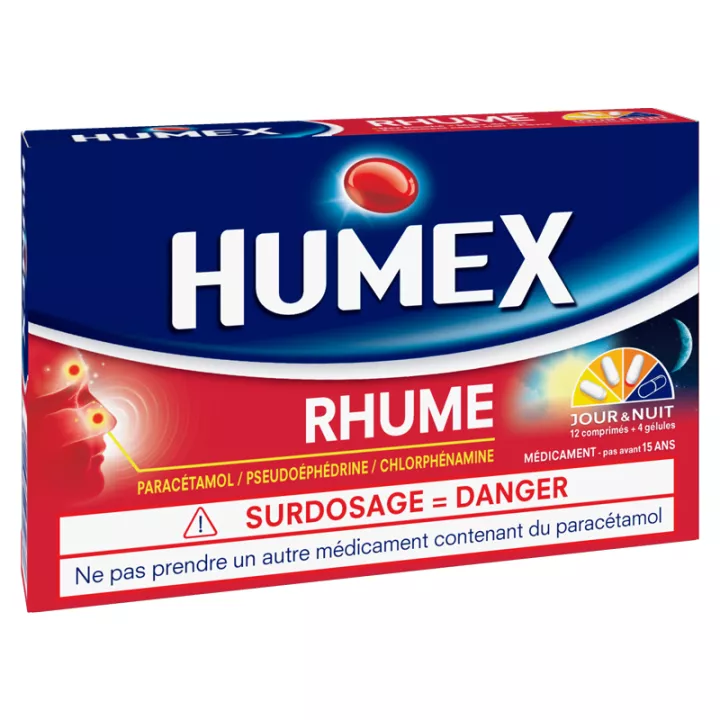NOTICE
ANSM - Last updated: 07/08/2012
Name of the medicinal product
HUMEXLIB PARACETAMOL CHLORPHENAMINE 500 mg / 4 mg capsule
framed
Read this leaflet carefully before you start taking this medicine. It contains important information for your treatment.
This medication can be used in self-medication, ie used without consultation or prescription from a doctor.
· If symptoms persist or worsen, seek advice from your pharmacist or doctor.
· This leaflet is designed to help you use the medicine well, so you may need to read it again.
· If you notice any side effects not listed in this leaflet, or if you experience any of the effects listed as serious, please tell your doctor or pharmacist.
Review summary
In this notice :
1. WHAT IS HUMEXLIB PARACETAMOL CHLORPHENAMINE 500 mg / 4 mg, hard capsule AND WHAT IT IS USED FOR?
2. BEFORE YOU TAKE HUMEXLIB PARACETAMOL CHLORPHENAMINE 500 mg / 4 mg capsule?
3. HOW TO TAKE HUMEXLIB PARACETAMOL CHLORPHENAMINE 500 mg / 4 mg capsule?
4. WHAT ARE POSSIBLE SIDE EFFECTS?
5. HOW TO STORE HUMEXLIB PARACETAMOL CHLORPHENAMINE 500 mg / 4 mg capsule?
6. ADDITIONAL INFORMATION
1. WHAT IS HUMEXLIB PARACETAMOL CHLORPHENAMINE 500 mg / 4 mg, hard capsule AND WHAT IT IS USED FOR?
Pharmacotherapeutic group
ANTIPYRETIC ANTALGES
ANTIHISTAMINIC INHIBITOR OF RECEPTORS H 1
This medicine contains paracetamol and an antihistamine, chlorphenamine.
Therapeutic indications
This medication is indicated for the treatment of colds, rhinitis, nasopharyngitis and influenza conditions in adults and children over 15 years of age:
· clear nasal discharge and tears,
· sneezing,
· headache and / or fever.
2. BEFORE YOU TAKE HUMEXLIB PARACETAMOL CHLORPHENAMINE 500 mg / 4 mg capsule?
List of information needed before taking the medication
Not applicable.
Cons-indications
Do not take HUMEXLIB PARACETAMOL CHLORPHENAMINE 500 mg / 4 mg capsule if:
· allergy known to one of the constituents of the capsule,
· severe liver disease,
· certain forms of glaucoma (increased pressure in the eye),
· difficulty passing urine of prostatic or other origin,
This medication SHOULD NOT BE GENERALLY USED, in case of breast-feeding.
IN CASE OF DOUBT, IT IS ESSENTIAL TO ASK FOR THE OPINION OF YOUR DOCTOR OR YOUR PHARMACIST.
Precautions for use; special warnings
Take special care with HUMEXLIB PARACETAMOL CHLORPHENAMINE 500 mg / 4 mg capsule:
Special warnings
DO NOT LEAVE THIS MEDICINE FOR CHILDREN
In case of overdosage or mistakenly taking too high a dose, immediately notify a doctor.
Concomitant use of this medication in combination with alcohol or medicines containing alcohol is not recommended ( see Take or use other medicines ).
This medication is not recommended for breast-feeding.
This medicine contains paracetamol and chlorphenamine maleate. Other medicines contain it. Do not combine them, so as not to exceed the maximum recommended doses ( see Dosage ). |
In the event of a nasal discharge, as in the case of aggravation or in the absence of improvement of your condition after 5 days of treatment (persistence of the fever ...), CONSULT A DOCTOR.
Precautions for use
If fever or pain persists, take the advice of your doctor or pharmacist.
Precautions are necessary in elderly people with prostate problems, predisposed to chronic constipation, dizziness or drowsiness.
If you have severe liver or kidney disease, tell your doctor to adjust the dosage.
This medication may cause drowsiness, increased by alcohol:
· it is best to start treatment one night,
· and to avoid drugs containing alcohol during the treatment period
IN CASE OF DOUBT, DO NOT HESITATE TO REQUEST THE OPINION OF YOUR DOCTOR OR YOUR PHARMACIST.
Interaction with other medicines
Taking or using other medicines
If you are taking or have recently taken any other medicines, including medicines obtained without a prescription, talk to your doctor or pharmacist.
Tell your doctor or pharmacist of all prescription and nonprescription / herbal products you may use before using this medication.
TO AVOID POSSIBLE INTERACTIONS BETWEEN SEVERAL MEDICINAL PRODUCTS, SYSTEMALLY REPORT ANY OTHER TREATMENT IN PROGRESS AT YOUR DOCTOR OR YOUR PHARMACIST.
This medication MUST BE AVOIDed in combination with alcohol or all medicines containing alcohol ( see Special Warnings ).
Interactions with food and beverages
Food and drinks
The consumption of alcoholic beverages should be avoided during the treatment period.
Interactions with Herbal Medicines or Alternative Therapies
Not applicable.
Use during pregnancy and lactation
Pregnancy and breast feeding
Pregnancy
This medication, under normal conditions of use, may be used during pregnancy, provided that this is for a short time (a few days) and at the recommended doses.
However, at the end of pregnancy, abuse of this drug can cause neurological effects in the newborn. Therefore, always seek the advice of your doctor before using it and never exceed the recommended dose.
feeding
This drug most likely passes into breast milk. Given its sedative properties that could affect your child (lethargy, decreased tone) or on the contrary exciting (insomnia), this drug is not recommended in case of breast-feeding.
Sport
Not applicable.
Effects on ability to drive or use machines
Driving and using machines
Attention is drawn to the risks of drowsiness associated with the use of this drug, especially in the beginning of treatment, especially among vehicle drivers and machine users.
This is exacerbated by the use of alcoholic beverages or alcohol-containing medications. It is best to start this treatment at night.
List of excipients with known effect
Not applicable.
3. HOW TO TAKE HUMEXLIB PARACETAMOL CHLORPHENAMINE 500 mg / 4 mg capsule?
Instructions for proper use
Not applicable.
Dosage, Mode and / or route (s) of administration, Frequency of administration and Duration of treatment
Dosage
Oral use.
Reserved for adults and children over 15 years of age.
1 capsule to be renewed if necessary after 4 hours minimum, without exceeding 4 capsules per day.
Administration mode
Oral use.
The capsules should be swallowed as is with a drink (eg water, milk, fruit juice).
Frequency of Administration
The catch must be spaced at least 4 hours apart. In case of severe kidney disease (severe kidney failure), catches will be spaced at least 8 hours apart.
Given the sedative effect of this drug, it is best to start treatment at night.
Duration of the treatment
The duration of use is limited to 5 days.
If the fever does not decrease after 3 days or if the clinical signs worsen, do not continue your treatment without the advice of your doctor.
Given the general clinical signs of infection, general antibiotic therapy should be considered.
Symptoms and Instructions for Overdose
If you take more HUMEXLIB PARACETAMOL CHLORPHENAMINE 500 mg / 4 mg capsule you should not have:
In case of accidental overdose or intoxication, STOP TREATMENT AND IMMEDIATELY CONSULT A DOCTOR.
Instructions for omission of one or more doses
If you forget to take HUMEXLIB PARACETAMOL CHLORPHENAMINE 500 mg / 4 mg capsule:
Do not take a double dose to make up for the missed dose.
Risk of withdrawal syndrome
Not applicable.
4. WHAT ARE POSSIBLE SIDE EFFECTS?
Description of adverse reactions
Like all medicines, HUMEXLIB PARACETAMOL CHLORPHENAMINE 500 mg / 4 mg capsule is likely to have side effects, although not everyone is subject to it.
Some side effects require STOPPING IMMEDIATELY TREATMENT AND WARNING A DOCTOR.
In some rare cases, it is possible that a rash or reddening or allergic reaction can occur, which can be manifested by a sudden swelling of the face and neck or by a sudden discomfort with drop in blood pressure. Immediately stop treatment, tell your doctor and never take any medicines containing paracetamol.
Exceptionally, biological changes requiring control of the blood balance have been observed: liver function disorders, abnormally low levels of certain white blood cells or certain blood cells such as platelets which may result in nosebleeds or gums. In this case, consult a doctor.
Other side effects may include:
· Drowsiness, decreased vigilance, more marked at the beginning of treatment,
· Drops in blood pressure when standing up, which may be accompanied by dizziness,
· Dry mouth, visual disturbances, urine retention, constipation, palpitations,
· Disorders of memory or concentration, confusion, dizziness, hallucinations,
· Difficulty in coordinating movements, tremors.
If you notice any side effects not listed in this leaflet, or if any of the side effects gets serious, contact your doctor or pharmacist.
5. HOW TO STORE HUMEXLIB PARACETAMOL CHLORPHENAMINE 500 mg / 4 mg capsule?
Keep out of the reach and sight of children.
Expiration date
Do not use HUMEXLIB PARACETAMOL CHLORPHENAMINE 500 mg / 4 mg capsule after the expiry date which is stated on the carton.
Storage conditions
This medication should be stored at room temperature and protected from moisture.
If necessary, warnings against visible signs of deterioration
Medicines should not be disposed of via wastewater or household waste. Ask your pharmacist what to do with unused medications. These measures will help protect the environment.
6. ADDITIONAL INFORMATION
Full list of active substances and excipients
What HUMEXLIB PARACETAMOL CHLORPHENAMINE contains 500 mg / 4 mg, capsule?
The active substances are:
Paracetamol ................................................. .................................................. .............................. 500.0 mg
Chlorphenamine Maleate ............................................... .................................................. .............. 4.0 mg
For a capsule.
The other components are:
Talc, sodium crosslinked carboxymethyl cellulose, sodium lauryl sulfate, anhydrous colloidal silica.
Composition of the capsule shell:
Head : Erythrosine - Indigotine - Gelatin
Body : titanium dioxide - gelatin.
Pharmaceutical form and content
What is HUMEXLIB PARACETAMOL CHLORPHENAMINE 500 mg / 4 mg capsule and contents of the pack?
This medication is in the form of a capsule. Box of 8, 12 and 16.
Name and address of the marketing authorization holder and the holder of the manufacturing authorization responsible for the release of the lots, if different
Holder
Laboratories URGO Health & Beauty
42, rue de Longvic
BP 157
21304 Chenove Cedex
exploiting
URGO Laboratories
42, rue de Longvic
21300 CHENOVE
Maker
URGO Laboratories
Avenue of Strasbourg
Zone Excellence 2000
21800 CHEVIGNY SAINT SAUVEUR
Names of the medicinal product in the Member States of the European Economic Area
Not applicable.
Date of approval of the notice
The last date on which this leaflet was approved is {date}.
AMM under exceptional circumstances
Not applicable.
Internet Information
Detailed information on this medicine is available on the Ansm website (France).
Information for health professionals only
Not applicable.
Other
SANITARY EDUCATION COUNCILS
"WHAT TO DO IN THE EVENT OF FEVER":
The normal temperature of the body varies from person to person and is between 36 ° 5 and 37 ° 5. An increase of more than 38 ° C may be considered a fever.
This medication is for adults and children over 15 years of age.
If the disorders that the fever causes are too troublesome, you can take this drug that contains paracetamol in accordance with the indicated dosages.
To avoid any risk of dehydration, consider drinking frequently.
With this medication, the fever should drop rapidly. However :
· if other unusual signs appear,
· if the temperature persists for more than 3 days or if it worsens,
· if the headache becomes violent, or in case of vomiting,
CONSULT YOUR DOCTOR IMMEDIATELY.
"WHAT TO DO IN CASE OF PAIN":
The intensity of the perception of pain and the ability to resist it vary from person to person.
· If there is no improvement after 5 days of treatment,
· If the pain is violent, unexpected and occurs in a brutal manner (notably a severe pain in the chest) and / or on the contrary returns regularly,
· If it is accompanied by other signs such as ujn state of general malaise, fever, unusual swelling of the painful area, decreased strength in a limb,
· If she wakes you up at night,
CONSULT YOUR DOCTOR.
